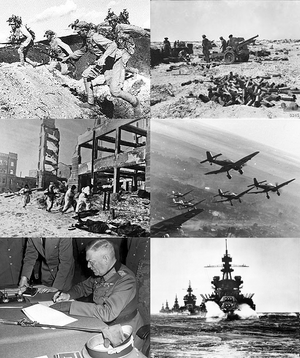| World War II | |||||||
|---|---|---|---|---|---|---|---|
 Clockwise from top left: Chinese forces in the Battle of Wanjialing, Australian 25-pounder guns during the First Battle of El Alamein, German Stuka dive bombers on the Eastern Frontwinter 1943–1944, US naval force in the Lingayen Gulf,Wilhelm Keitel signing the German Surrender, Soviet troops in the Battle of Stalingrad | |||||||
| |||||||
| Belligerents | |||||||
| Allies | Axis Co-belligerents Puppet states | ||||||
| Commanders and leaders | |||||||
| Allied leaders | Axis leaders . | ||||||
| Casualties and losses | |||||||
| Military dead: Over 16,000,000 Civilian dead: Over 45,000,000 Total dead: Over 61,000,000 (1937–45) | Military dead: Over 8,000,000 Civilian dead: Over 4,000,000 Total dead: Over 12,000,000 (1937–45) | ||||||
World War II, or the Second World War (often abbreviated as WWII or WW2), was a global military conflict lasting from 1939 to 1945, which involvedmost of the world's nations, including all of the great powers: eventually forming two opposing military alliances, the Allies and the Axis. It was the most widespread war in history, with more than 100 million military personnel mobilised. In a state of "total war," the major participants placed their entire economic, industrial, and scientific capabilities at the service of the war effort, erasing the distinction between civilian and military resources. Marked by significant events involving the mass death of civilians, including the Holocaust and the only use of nuclear weapons in warfare, it was the deadliest conflict inhuman history, resulting in 50 million to over 70 million fatalities.
The war is generally accepted to have begun on 1 September 1939, with the invasion of Poland by Germany and Slovakia, and subsequent declarations of war on Germany by France and most of the countries of the British Empire and Commonwealth. Germany set out to establish a large empire in Europe. From late 1939 to early 1941, in a series of campaigns and treaties, Germany conquered or subdued much of continental Europe; amid Nazi-Soviet agreements, the nominally neutral Soviet Union fully or partially occupied and annexed territories of its six European neighbours. Britain and the Commonwealth remained the only major force continuing the fight against the Axis in North Africa and in extensive naval warfare. In June 1941, the European Axis launched an invasion of the Soviet Union, giving a start to the largest land theatre of war in history, which, from this moment on, was tying down the major part of the Axis military power. In December 1941, Japan, which had been at war with China since 1937, and aimed to dominate Asia, attacked the United States and European possessions in the Pacific Ocean, quickly conquering much of the region.
The Axis advance was stopped in 1942 after the defeat of Japan in a series of naval battles and after defeats of European Axis troops in North Africa and,decisively, at Stalingrad. In 1943, with a series of German defeats in Eastern Europe, the Allied invasion of Fascist Italy, and American victories in the Pacific, the Axis lost the initiative and undertook strategic retreat on all fronts. In 1944, the Western Allies invaded France, while the Soviet Union regained all territorial losses and invaded Germany and its allies.
The war in Europe ended with the capture of Berlin by Soviet and Polish troops and the subsequent German unconditional surrender on 8 May 1945. The Japanese Navy was defeated by the United States, and invasion of the Japanese Archipelago ("Home Islands") became imminent. The war in Asia ended on 15 August 1945 when Japan agreed to surrender.
The war ended with the total victory of the Allies over Germany and Japan in 1945. World War II altered the political alignment and social structure of the world. The United Nations (UN) was established to foster international cooperation and prevent future conflicts. The Soviet Union and the United States emerged as rival superpowers, setting the stage for the Cold War, which lasted for the next 46 years. Meanwhile, the influence of European great powers started to decline, while the decolonisation of Asia and Africa began. Most countries whose industries had been damaged moved towards economic recovery. Political integration, especially in Europe emerged as an effort to stabilise postwar relations.
No comments:
Post a Comment